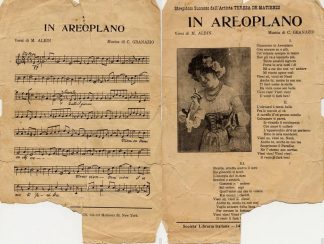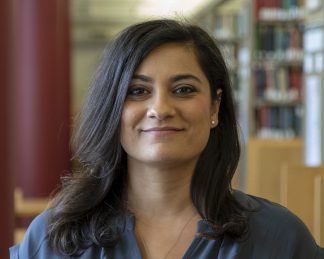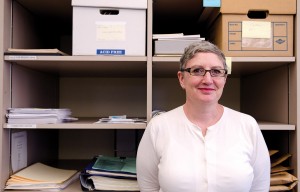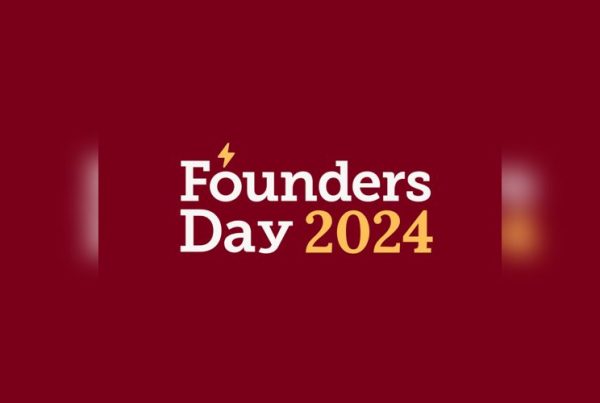By Allison Campbell-Jensen
One person’s introduction flows into a solo by another, who quotes a surprising source, then the third fills in with improvisation informed by experience — in the style of a jazz trio, Cecily Marcus, Maura Coonan, and Jessica Abbazio created an Archives Q & A conversation video for the MUS 5611 research methods class.
From describing what an archive is, to offering tips and outlining search strategies, the trio welcomes students into a world with a different tempo and perhaps surprising expectations.
Yet no matter what the query, archivists respond to the call. “We will do what we can to make things accessible,” Marcus says. Coonan adds: “We love to help. Use us . . . that’s what we’re here for.”
Not missing a beat
The roots of their performance this spring were in planned in-person introductions to Archives & Special Collections in Andersen Library. When #StayAtHome became the new reality to address the challenge of COVID-19, and the U switched to online instruction, Music Librarian Abbazio was grateful that Marcus and Coonan were willing to alter their approach.
In the video, Marcus, as Curator of the Performing Arts Archives (as well as for the Givens Collection of African American Literature and the Upper Midwest Literary Archives), takes an expected role in introducing graduate-level music students to archives and primary source research. A certain swing comes from Coonan, an Assistant Archivist for the Immigration History Research Center Archives, which include a lot of music, newspapers (which ran ads and performance reviews), recordings, and even musical instruments.
“Music was a big part of maintaining their culture” for people who came to North America from countries around the world, Coonan says.
Students outside the United States
When campus buildings closed, some members of the graduate-level music class returned to homes outside the United States. So Abbazio decided that, rather than using Zoom, which might require someone in a far-flung location to log on at 2 in the morning, she and the curators would record the class video on using archives.
The conversation was not scripted, although Abbazio had sent the curators a sheet on what topics to cover.
“When we got on the call, we said that I would start answering the question and Maura would follow up,” Marcus says. “It became a bit more organic than that as we went on.”
Coonan says she is glad that Marcus, who is more experienced, took the lead, as it relieved some performance pressure for her.
“It turned out to be really great,” Coonan says. “I really enjoyed doing it in this format.” The archivists also created an online guide for the class.
Progression: Performer to researcher
Another fan of the format is flutist Lexi Brouillard.
“Since we had to move online, I can actually go back and look at the video again,” says the student, who is in the first year of her Masters of Music program. It was especially helpful, she says, because “I’ve never done archival research before.”
It’s less common for the School of Music performance students to have had past experience with conducting archival research, as compared with those studying musicology or ethnomusicology, Abbazio says. “For them to have a chance to hear from archivists and to understand the kind of resources that are available? The feedback I’ve gotten from them is ‘Wow, I didn’t even know this stuff existed and I could use it for my research — let alone how.’”
Riffing while researching
Starting with an overture she loved playing, Brouillard began the class looking for primary sources about Richard Wagner’s opera The Flying Dutchman. But she soon recognized this choice was unwieldy given the size of the scores. She switched her topic to Mozart’s Flute Concerto No. 1 in G Major. It was more practical, although a bit ironic, as Mozart didn’t like the flute.
Odder still, Brouillard says, was her discovery that “a primary source in Mozart’s hand [of that concerto], doesn’t exist. What are we playing from? . . . I would love to do more research into that.”
Among the specific research insights she learned were that some archives require notice weeks or even a month before visiting.
“You can’t simply jump on a plane to Berlin,” she says, “When you get there, you may need permission or a letter of introduction.” Yet requesting instead that resources in distant archives be scanned can become very expensive. What’s an alternative to in-person visits? “Researchers for hire,” she says, adding: “I thought that was funny.”
Along with beginning a search using Google, book and article footnotes and endnotes, and databases, Coonan offered in the video that researchers love helping other researchers on Twitter, using hashtags like #twitterstorians to pose queries.
“I never thought I would use Twitter for research,” Brouillard says. “That’s pretty cool.”
Signature: Unexpected aspects of archival research
For those brought up to ask a personal digital assistant for instant answers, the time requirements of archival research may be a surprise. Digging into archives, while rewarding, can be time-consuming. For some, it’s because of one’s personal pace, Coonan says, mentioning a person might take a day to go through a folder. Or an archive may include a mountain of material — like 300 boxes on the Minnesota Orchestra, notes Marcus.
That’s why consulting an archivist can help set the tone for a successful research project. Moreover, Coonan says she “loves” one-on-one consultations. “The students learned the most from one-on-one consultations because everything we told them is related to their interests and their research. . . . So I hope people contact me from Jessica’s class.”
She adds that some millennials may not like to talk on the phone or directly contact people. Yet, as a millennial herself, she hopes they will reach out anyway. “If you want to do your research well and find everything that will relate to your topic, you have to contact an archivist.”
Marcus adds that connecting to one archivist connects a researcher to others and, sometimes, to the trove being sought. Her own doctoral research in cultural studies and comparative literature at the U focused on Argentina’s underground culture during the authoritarian dictatorship of the 1970s and ‘80s. “There was actually an archive that had all of these underground magazines. [But] when I first went to Argentina, I didn’t know it existed,” Marcus says. “When I got there, it took one person five seconds to say, ‘I know where you need to go.’”
Outro
Marcus and Coonan’s attitudes and their expertise make their contributions to the students’ future research very valuable, says Abbazio. “To see Cecily and Maura, to put faces to names, to get that kind of positive reinforcement and encouragement, is ground-breaking for them.”
Says Marcus: “We do know that archives can be complicated. They are not straightforward. You are not going to find exactly what you’re looking for. You’re not always going to find the listing of the collection in the library’s catalog. We do want to make those pathways as clear as we can.”
Throughout, the trio passes to these music students the power of research to move from discovery and improvisation into the excitement of composing something new.






